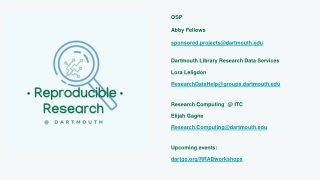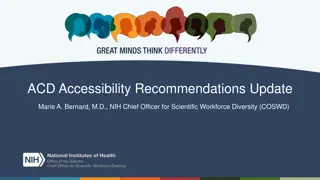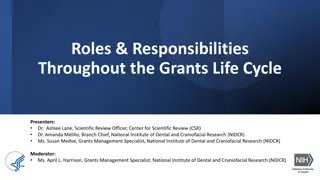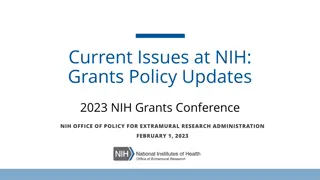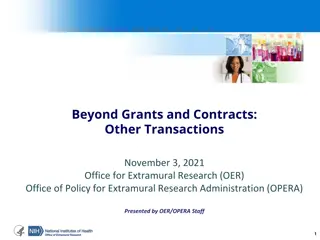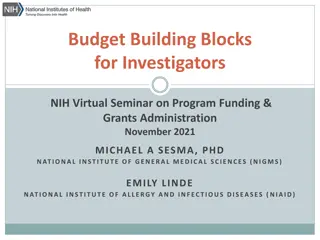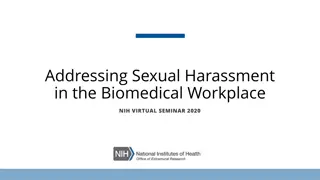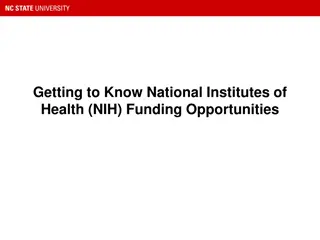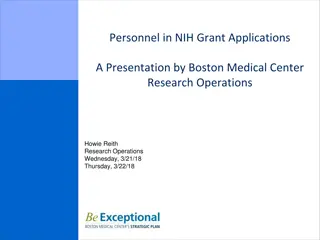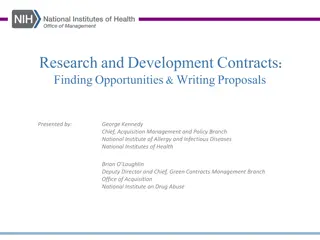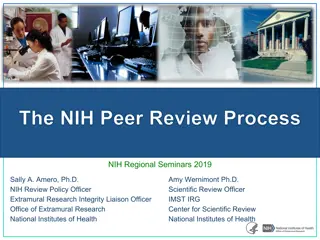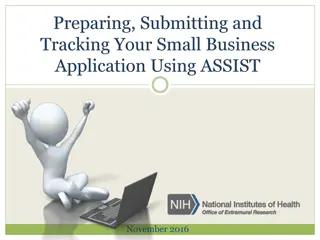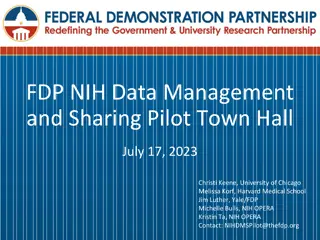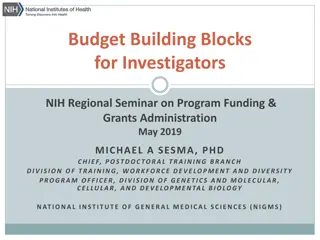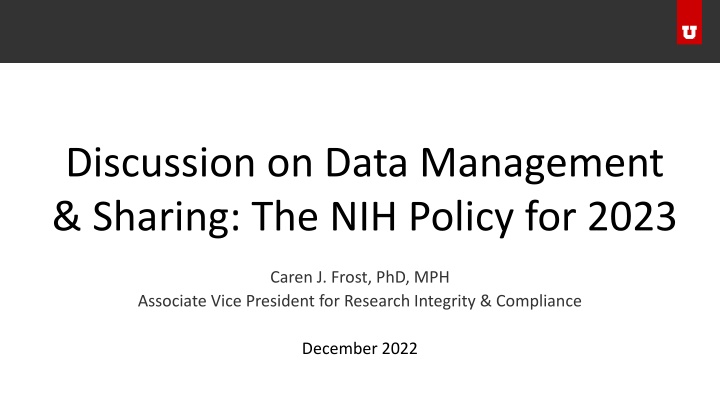
NIH Data Management and Sharing Policy Overview
Explore the key aspects of the NIH Data Management and Sharing Policy for 2023, including policy parameters, repositories, data management plan structure, and compliance requirements. Learn about the submission of data management and sharing plans, elements of a DMS plan, and considerations for data preservation, access, and reuse.
Download Presentation

Please find below an Image/Link to download the presentation.
The content on the website is provided AS IS for your information and personal use only. It may not be sold, licensed, or shared on other websites without obtaining consent from the author. If you encounter any issues during the download, it is possible that the publisher has removed the file from their server.
You are allowed to download the files provided on this website for personal or commercial use, subject to the condition that they are used lawfully. All files are the property of their respective owners.
The content on the website is provided AS IS for your information and personal use only. It may not be sold, licensed, or shared on other websites without obtaining consent from the author.
E N D
Presentation Transcript
Discussion on Data Management & Sharing: The NIH Policy for 2023 Caren J. Frost, PhD, MPH Associate Vice President for Research Integrity & Compliance December 2022
Overview of Presentation Describe the NIH policy parameters Highlight repositories at the UU and other reputable locations Examine how to structure a data management and sharing plan for NIH (and other federal funding agency) proposals Review guidance document Discuss next steps from the AVPRIC office
NIH Data Management and Sharing (DMS) Policy The DMS Policy applies to all NIH funding mechanisms Applies to all research, funded or conducted in whole or in part by NIH, that results in the generation of "scientific data . "Scientific data" is defined as: "the recorded factual material commonly accepted in the scientific community as of sufficient quality to validate and replicate research findings, regardless of whether the data are used to support scholarly publications." NIH has a longstanding commitment to making the results of research available
Submission of Data Management & Sharing Plan with all applications for funding beginning January 25, 2023 Policy Requirements Compliance with the Data Management and Sharing Plan approved by the funding NIH Institute, Center, or Office
Elements of a DMS Plan Data type Identifying data to be preserved and shared Related tools, software, code Tools and software needed to access and manipulate data Standards Standards to be applied to scientific data and metadata Data preservation, access, timelines Repository to be used, persistent unique identifier, and when/ how long data will be available Access, distribution, reuse considerations Description of factors for data access, distribution, or reuse Oversight of data management and sharing Plan compliance will be monitored/ managed and by whom Data Type Oversight of Data Managem ent and Sharing Related tools, Software and/or Code Plan Elemen ts Access, Distribution, or Reuse Consideratio ns Standards Data Preservatio n, Access and Associated Timelines
Data Management and Sharing Costs ALLOWABLE COSTS: UNALLOWABLE COSTS: Curating data/developing supporting documentation Preserving/sharing data through repositories Local data management considerations IMPORTANT: Must be incurred during the performance period Infrastructure costs typically included in indirect costs Costs associated with the routine conduct of research (e.g., costs of gaining access to research data)
DMS Plan Assessment / Effective Dates NIH Program staff: Ensure Elements of a DMS Plan have been adequately addressed and assess the reasonableness of those responses Applications will only be funded when Plan is complete and acceptable Peer reviewers: Consider if budget is reasonable Competing applications submitted for Jan 25, 2023, and subsequent receipt dates Extramural Proposals submitted on or after Jan 25, 2023 Contracts Projects conducted on or after Jan 25, 2023 Intramural Other funding agreements (e.g., Other Transactions) Executed on or after Jan 25, 2023, unless otherwise stipulated by NIH
Sharing Scientific Data Finding and Selecting a Repository Established repositories encouraged NIH ICs may designate specific data repository(ies) Recommend using a data-type or discipline- specific repository if available Other suitable options include: Institutional repositories PubMed Central (small datasets only) Generalist repositories When to share data? Share data as soon as possible: No later than the time of a publication of findings in a peer-reviewed journal OR at the end of the award, whichever comes first DMS Plans should maximize appropriate sharing Justifiable ethical, legal, and technical factors for limiting sharing include: Informed consent will not permit or limits scope of sharing or use Privacy or safety of research participants would be compromised and available protections insufficient Explicit federal, state, local, or Tribal law, regulation, or policy prohibits disclosure Restrictions imposed by existing or anticipated agreements with other parties
Selecting a Repository For some programs and data types, NIH and/or Institute, Center, Office (ICO) and Funding Opportunity Announcements (FOA) may identify specific repositories If no specific repository specified then: #consider discipline or data-type specific NIH-supported repos (~114) #for small datasets <2GB, consider PubMed Central (supplemental material) #generalist repos or institutional repos (like UU s Hive) #cloud-based data repos for large datasets
Hive (UU data repository): Features Selecting a data repository Metadata Hive numbers Total datasets in Hive: 66 Public (63) University of Utah (1) Private (2) PersistentIdentifiers: DOI, ORCID iD License: Creative commons, other options Visibility: Public, University of Utah, Private File Types: Most common types accepted Dataset sizes: 2MB 400GB User accounts: 137 Top File Formats Zip X-python (python script, ascii executable) X-gzip Csv Netcdf X-c Octet-stream Json X-fortran
Center for High Performance Computer (CHPC) https://home.chpc.utah.edu/~uNID/public_html Any researcher can get a free CHPC account which comes with 50 GB (gigabytes) of $HOME directory space. This is not backed up unless your PI has purchased home directory space! Cost is $900 TB, good for 5 years. Project space Any researcher can purchase NFS RAID6 storage space (which is mountable from CHPC resources or more generally via Samba). A WWW interface can be set-up, e.g. https://amber.utah.edu. Cost is $150/TB, good for 5-7 years.This space is not backed up! Object storage CHPC has deployed Ceph based object storage (S3) similar to Cloud storage. Cannot NFS mount. Cost is $150/TB, good for 5-7 years.
Other Options Box https://box.utah.edu 1 TB limit, 50 GB file size limit. Microsoft Office365 OneDrive https://o365cloud.utah.edu Can be used for sensitive and restricted data. 1 TB limit, 2 GB file size limit. Google Drive https://gcloud.utah.edu Official U of U site says 25 GB per student, 150 GB for faculty and staff. Cost above 150 GB is $170 / TB-year. All three can be used for sensitive and restricted data so be careful when sharing links! LabArchives https://mynotebook.labarchives.com/login - An electronic lab notebox which is tied into the University Box account (and limits). See: https://campusguides.lib.utah.edu/labarchives/home
More Information https://www.chpc.utah.edu or helpdesk@chpc.utah.edu http://bit.ly/3Xnnb9d (Research Data Management Resources at the U) https://sharing.nih.gov/data-management-and-sharing- policy
Next Steps Establish a steering committee to address curation of data Set up a page on the AVPRIC s website for people to provide feedback and ask for assistance Develop a system to assist in maintaining/monitoring DSMPs Provide support for research teams across campus
Wrap Up (Q&A) The purpose of the NIH policy is to promote a culture change How we think about data How we think about how to use data How we think about who can access and use data Consider the role data play in the research mission of a higher education institution Review the guidance document Questions?
Resources Marriot Library (Harish Maringanti) Eccles Library (Catherine Soehner) NSF (Manish Parashar) CHPC (Tom Cheatham) ORIC (Caren Frost)

